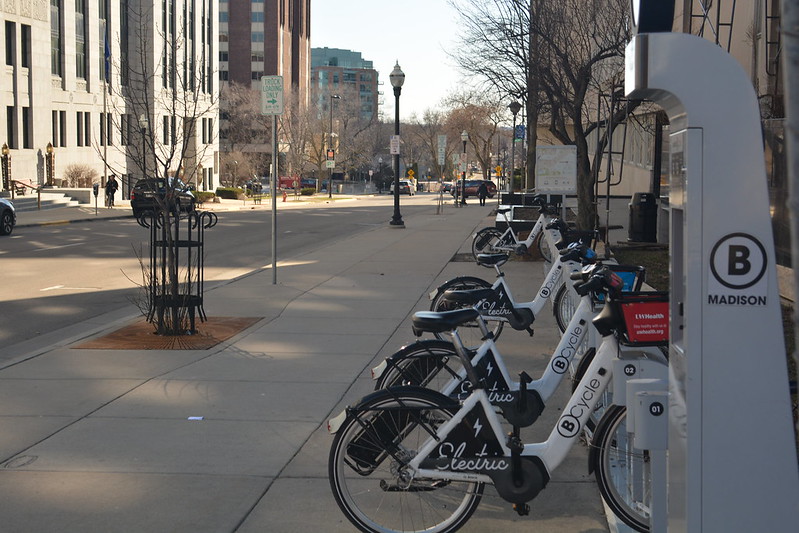Powering up communities: New grant to accelerate electrification & smart growth
Across the country, municipalities and transit agencies are beginning to embrace electrification in local transportation. They’re showing that the future of transportation does not have to be just electrified cars. And thanks to the Joint Office of Energy and Transportation, there’s a new funding opportunity to help local communities go electric.

In our Smart Growth and EVs series, we outlined some of the electrifying strategies that work hand-in-hand with the existing benefits of smart growth development. Among them, we singled out e-bikes/e-micromobility, carshare, multifamily housing, curbside charging challenges, and charger-oriented development. While projects are ramping up across the country to build out the NEVI program’s new network of interstate charging stations, programs that support opportunities to walk, bike, and take public transit have often started not at the national level, but in our own backyards.
Thanks to flexible provisions in the Infrastructure Investment and Jobs Act, a new grant program from the Joint Office of Energy and Transportation will put $54 million in funding in communities’ hands to help pilot and expand electric mobility options through smart growth strategies. The grant will support expanded access for people who can’t charge at home (like apartment dwellers), electric fleets, and managed charging to help fill in the gaps that larger programs might be missing.
Supporting electric fleets
Fleets of all sizes move forward under this grant—and for good reason. Electrified fleets can offer big bonuses for operators. Over the last few months, transit agencies and states have had the opportunity to apply for funding to expand clean bus fleets under the Low or No Emission Bus Program. However, they’re not the only entities that could use electric fleets to decarbonize mobility. Work to innovate and expand micromobility, light duty, and medium duty fleets are all eligible for this grant—and there’s been no shortage of innovative deployments in cities and localities already.
The Washington, DC region’s Capital Bikeshare system has seen ridership explode as of late. The DC region itself is full of hills, and when it comes to protective, modern bike infrastructure, DC is falling behind its peer cities. Despite that, ridership continues to grow. In March 2024, the bikeshare system saw over 430,000 trips, up over 50 percent from the previous year and continuing a trend of record use. There’s a culprit powering the trend—of all rides, about 50 percent were on the system’s newer e-bikes. And these big ridership boosts didn’t take much; only 1 in 7 bikes in the fleet are actually electrified. As a force for equitable mobility and transportation decarbonization, e-bike shares continue to stand out as a key strategy. (And this only scratches the surface once you consider the huge potential to reduce emissions from new e-bike subsidies, like those in Colorado and other states have).
Advancing EV carshare
Some localities have partnered with nonprofits to offer electric carshare that offers low-emission mobility to those who need it most. Evie Carshare in Minneapolis-St.Paul region, and Colorado Carshare in Denver metro help undercut costly car ownership by allowing people to use EVs only when they need them. Under this grant, non-profit organizations (like Evie Carshare and Colorado Carshare) and for-profits alike would be eligible for funding to plan, pilot and deploy fleets with awards up to $4 million.
Strengthening smarter charging infrastructure
Looking forward to a future powered by renewable energy and zero-emission fleets, one challenge will be balancing energy needs against generation capacity. Even today, increased demand for electricity from both EVs and development can be too much for existing utilities in certain areas. How municipalities and utilities will coordinate to increase capacity remains an open question. Managed charging helps alleviate these issues before they happen by leveraging software and systems to ensure that vehicles get charged at times most optimal for the grid and the vehicle. This program seeks to get ahead of these issues that dense, in-demand locations are very likely to face. And for many of those people who live in multifamily housing, new projects for charging models that minimize frustrating charger queues and enable curbside charging near essential destinations could make all the difference to electrify trips. Introducing mobility wallets that hold funds people could use for any mode (from transit, e-bikeshare time or EV carshare) could streamline charging even further.
Going beyond the main funding programs for electrification (like the National Electric Vehicle Infrastructure, Charging and Fueling Infrastructure, and Low or No Emission programs) it’s a great sign that the Joint Office is still looking for ways to deliver funding where it’s still needed and could offer scalable decarbonization benefits with improvements. This is especially true when the funding opportunities play so well with smart growth strategies.



















